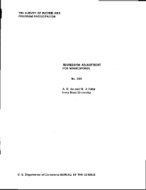Regression Adjustment for Nonresponse
Regression Adjustment for Nonresponse
Introduction
The Census Bureau designed the Survey of Income and Program Participation (SIPP) to provide improved information on participation in government programs. Characteristics of persons and households which may have impact on income and program participation are collected in the SIPP surveys.
The SIPP is a multistage stratified (72 strata) cluster systematic sample of the noninstitutionalized resident population of the United States, where the cluster is a household. The sample is the sum of four equal sized rotation groups. Each month one rotation group was interviewed. One cycle of four interviews for the four groups is called a wave. Several waves which cover a period of time are called a panel. For example, Panel 1987, composed of seven waves, contains the SIPP-interviewed people from February 1987 through May 1989. The survey produces two kinds of estimates: cross-sectional and longitudinal. In order to be a part of the longitudinal sample, the respondent must provide data at each of seven interview periods. About 79% of those that responded at the first interview (Wave One) of Panel 1987 also responded at the remaining six interviews. A total of 30,766 people interviewed in Wave One were eligible for the 1987 panel longitudinal sample. A total of 24,429 individuals completed all seven interviews. Estimation for the longitudinal sample uses information from all Wave One respondents and also uses control information from the Current Population Survey. We compare alternative estimators that use the information in different ways.
Longitudinal estimators are derived from the weights assigned to the people in the longitudinal sample. Many weighting procedures have been investigated for the longitudinal sample. The current weighting scheme at the U.S. Census Bureau is described by Waite (1990). The procedure makes two adjustments to the base weights, where the base weights are the reciprocals o[ the probabilities of selection. The adjustments attempt to compensate for nonresponse and undercoverage, using variables thought to be highly correlated with SIPP variables of interest. The first stage adjustment is of the post stratification type. The cells are defined by characteristics of people who were eligible in the Wave One sample. The second stage adjustment is a raking procedure, performed after the first adjustment, using data form the Current Population Survey as controls.
We treat the Panel 1987 SIPP data as a three-phase sample, where the phase I sample is the Current Population Survey. In the analysis, we assume zero error in the estimates of the phase I sample. The phase II sample is the 1987 Wave One data. The phase II included all the people who were eligible and participated in the survey during Wave One. The phase III sample is defined as a subsample from the phase II which includes all people who participated in the survey from Wave One through Wave Seven unless they died or moved to an ineligible address. The phase III sample is also called the longitudinal sample of panel 1987.
We use Poisson Sampling to model the response behavior by assuming that the sample units in the phase III sample are selected with "response probabilities" and that response is independent from person to person. It can be shown that under mild conditions, incorporating the response probabilities into the regression will yield consistent estimators. We describe a procedure to estimate the response probabilities when they are unknown. We will compare the three-phase regression estimators using different sets of weights in the regression. One set of weights is the sampling weights. The second set of weights is the sampling weights adjusted by the estimated response probabilities. Estimated standard errors of the estimators using these two sets of weights are also compared.
Others in Series
Working Paper
Working Paper
Working Paper






